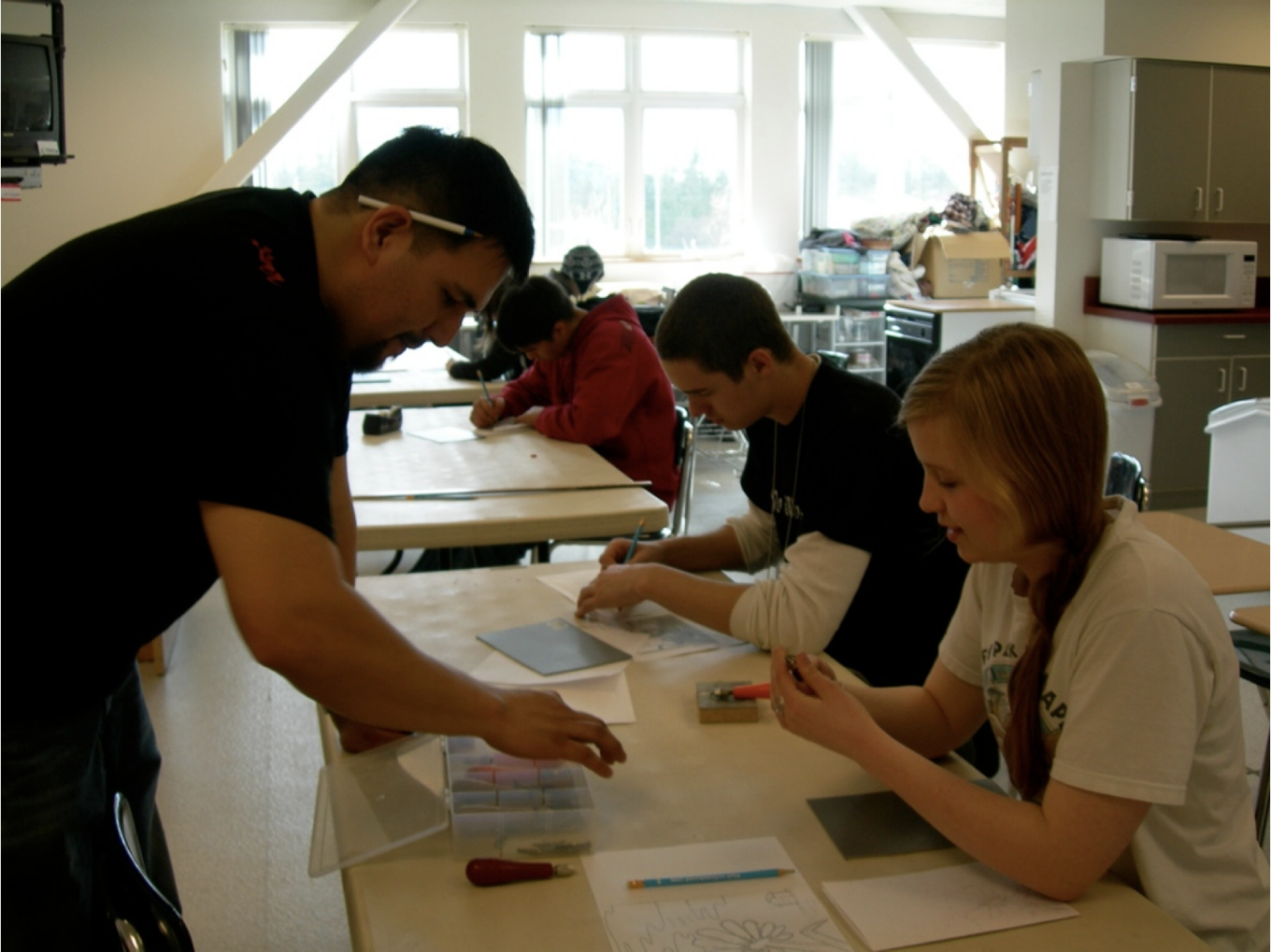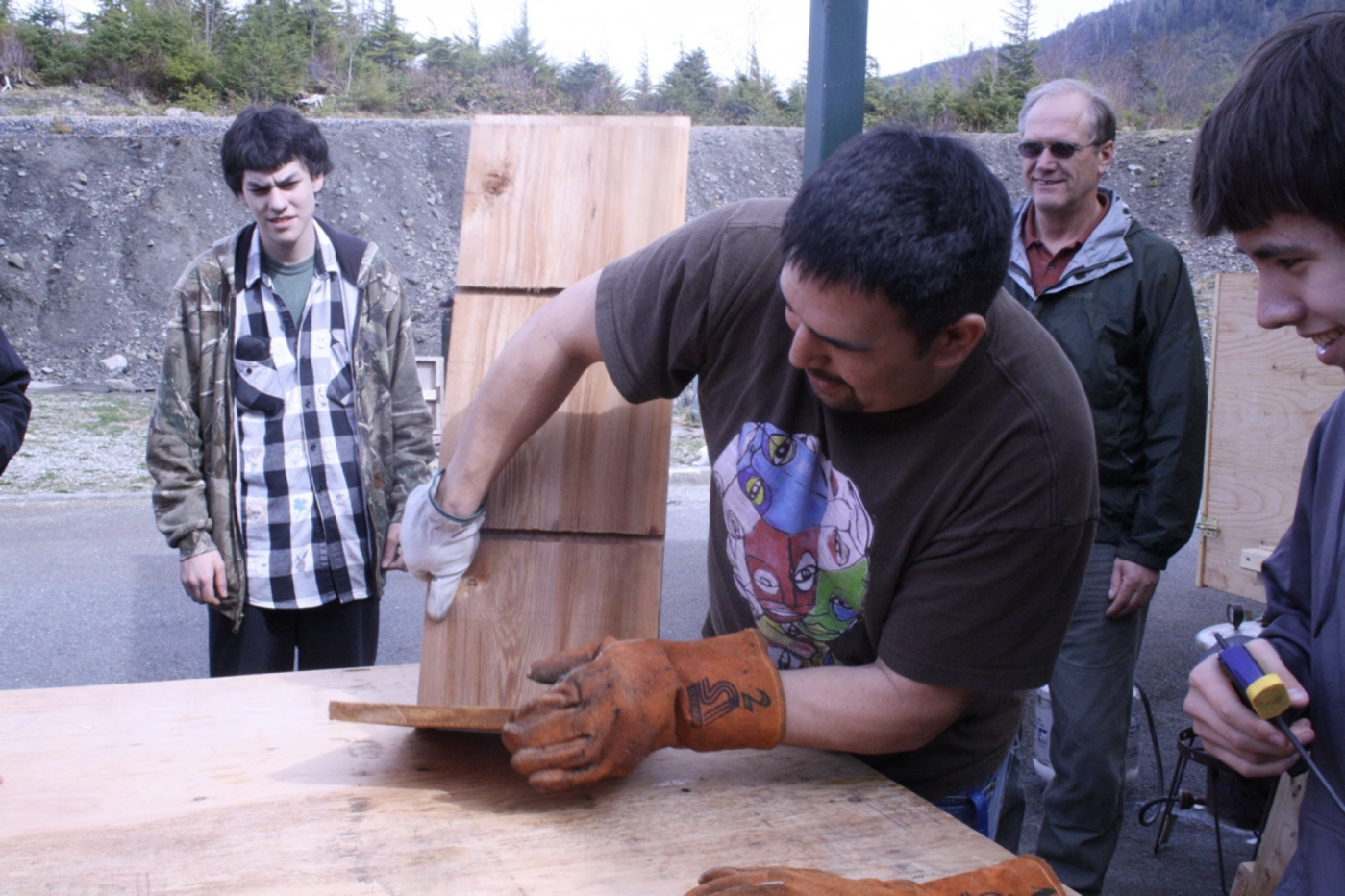
Ronnie Fairbanks on Formline, Skateboards, and Showing Students ‘Aha’ Moments through Art
September 24, 2024
By Alex Taitt, Assistant Curator, Digital Content & Programs
Tlingit, Ts’mysen and Chippewa artist Ronnie Fairbanks was born and raised in Albuquerque, New Mexico in a family that nurtured his artistic and creative spirit.

Ronnie with his grandmother, Sophie. As a young student, Fairbanks struggled in school with dyslexia until he found he exceled in hands-on classes like wood shop, welding, and automotive repair. Although he never took an art class in high school, his mother encouraged him to pursue art in his post-secondary education.
Fairbanks shares, “I didn’t really feel the artistic side or see it in myself, but my mother told me I gotta go to school or she was going to take away my truck, so that was that!”
Fairbanks enrolled at the Institute of American Indian Art in Santa Fe in 1995. After a few years, Fairbanks found himself drawn to Northwest Coast Indigenous art and transferred to the Northwest Indian College in Bellingham, Washington to learn more about formline design.
There he met his mentor, Eli Milton, a Ts’mysen artist from Metlakatla who gave Fairbanks his first lessons in Northwest Coast iconography and carving techniques.
“Eli was an awesome teacher, super down to earth, super friendly ... Just like an uncle to me,” Fairbanks says. Milton taught him the fundamentals of formline design, including differences between southern Coast Salish and northern styles, drawing in proper sequences, mask carving, and more, which shaped Fairbanks’ artistic approach moving forward.
After a few years in Bellingham, Fairbanks met his future wife, Teresa. With family ties to Klawock and Craig, they decided to visit with no real plans of what to do next. They ended up staying and finding a home in Alaska.
When Fairbanks arrived in Craig with no plan and no job prospects, his cousin asked him to help teach middle schoolers in the Indigenous Arts curriculum at the local school.
“At the time, I had no desire to be a teacher, but I needed money. I needed a job. So, I figured what the heck, I’ll give it a try,” Fairbanks reminisces. Over two decades later, he is just beginning his 21st year of teaching in Craig. “It was the best decision I ever made, I love my job,” says Fairbanks.

Being an educator has had a tremendous impact on Fairbanks’ perspective as an artist.
“As an artist-educator, you try to incorporate everything that you practice into your teaching,” says Fairbanks. He wants to show his students that if they work hard and put the time in, they can pursue art professionally. Opening up the possibility of art as a career goal is an important focus of his teaching.

For emerging artists and youth just getting their start, Fairbanks recommends practice and focusing on the basics: “practice comes first and foremost, just put the hours in and stick with the basics. Once you get the basics down, everything else will come from that. Just draw, draw, draw whenever you have the time.” He impresses the importance of practice and repetition in particular to master the complex visual system of formline design.

Fairbanks with middle school students at the Sealaska
Heritage STEAM Academy during summer 2023.For emerging artists and youth just getting their start, Fairbanks recommends practice and focusing on the basics: “practice comes first and foremost, just put the hours in and stick with the basics. Once you get the basics down, everything else will come from that. Just draw, draw, draw whenever you have the time.” He impresses the importance of practice and repetition in particular to master the complex visual system of formline design.
When he’s not teaching, Fairbanks finds inspiration in the rhythms and activities of everyday life: on the water in a fishing boat, skateboarding around town, or flipping through books of formline “Old Masters.”
Fairbanks says he likes to “put my own twist on things, to think outside of the box,” creating designs for skateboards and t-shirts, deriving pleasure from work that can be worn and used. His designs maintain many of the fundamental rules of the artform while incorporating fresh references and motifs.
He also likes to use skateboards as a canvas for students to practice their formline techniques in the classroom: "And if my kids get in trouble, they have to draw ovoids,” Fairbanks jokes.
For the 2024 Anchorage Museum exhibition Northern Boarders, Fairbanks designed and painted four skateboards. Each skate deck incorporates original formline designs that tell stories of the sky, incorporating shades of blue, black, and the natural maple wood of the board.
“I love painting on skateboards, they’re a really cool canvas. I love the boundaries a skate deck creates and the challenge of it,” Fairbanks says.
Skateboarding and snowboarding were part of Fairbanks’ life from a young age and continue to permeate his art practice.
Being an artist in Southeast Alaska is both full of opportunities and challenges. Fairbanks loves the small, tight-knit community and how everyday life influences his artmaking. On the other hand, sharing and promoting his work can be a challenge due to geographic isolation and high shipping costs.
Social media has helped mitigate some of the challenges, along with representation by the Stonington Gallery in Seattle and the Houston Museum of Natural Science. Working with institutions like Sealaska Heritage Institute and collaborating with other artists has also helped inject fresh energy into his practice.
At the end of the day, though, Fairbanks is content to be making a difference in the lives of his students through art.
“It’s great to show kids how to create, and when they get that ‘aha’ moment—it’s one of the coolest things for me.”
Follow along this fall as we learn more about Ronnie Fairbanks and his art practice on social media and catch his livestream on Tuesday, November 19, 2024 from 4 to 5 p.m. on Facebook Live.






